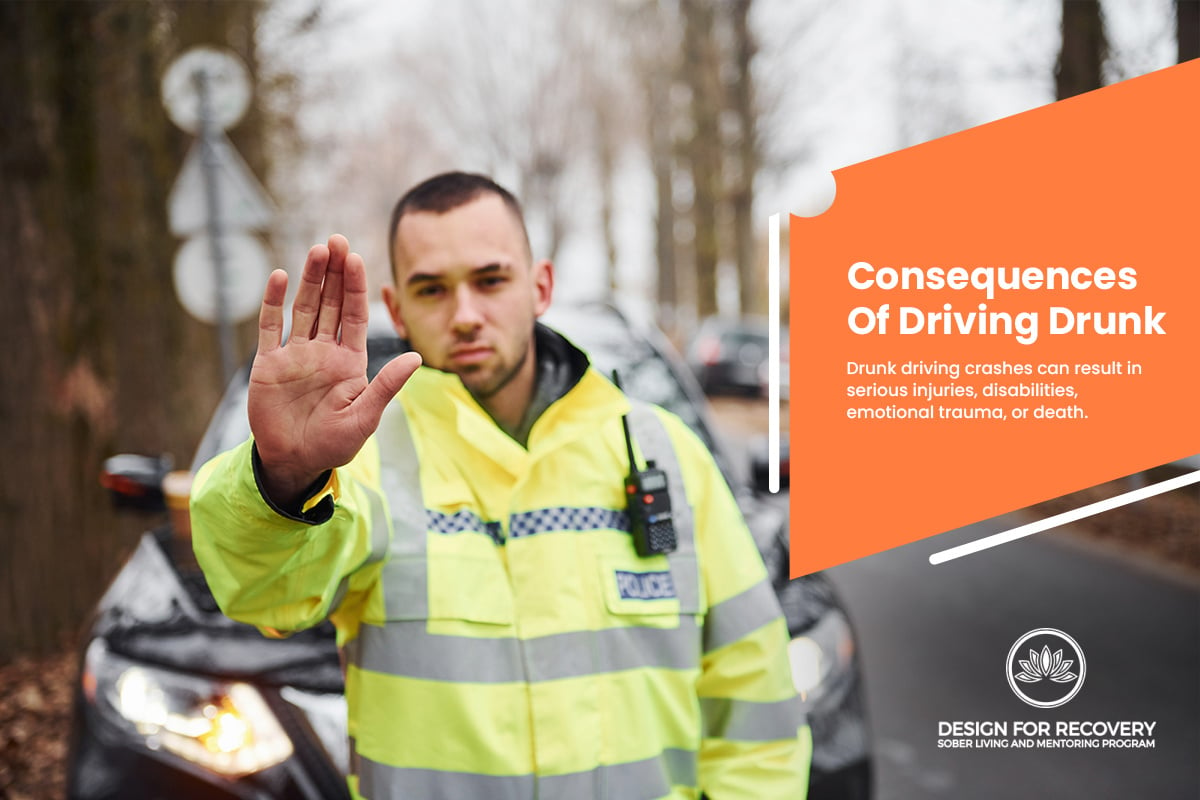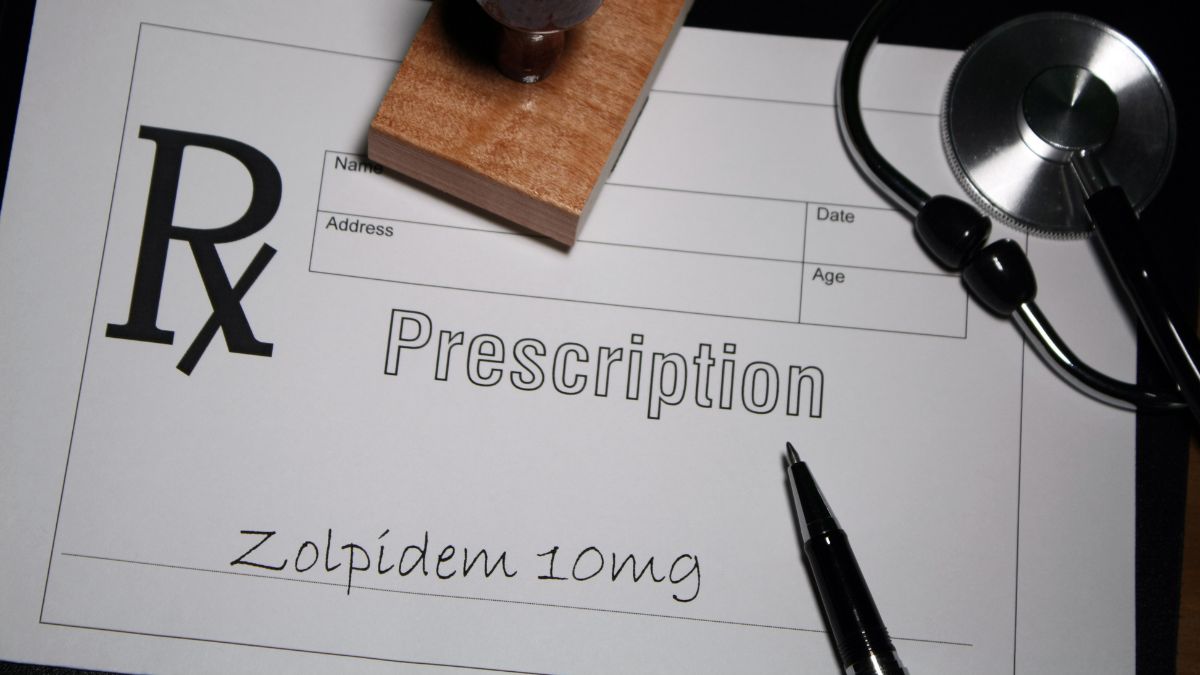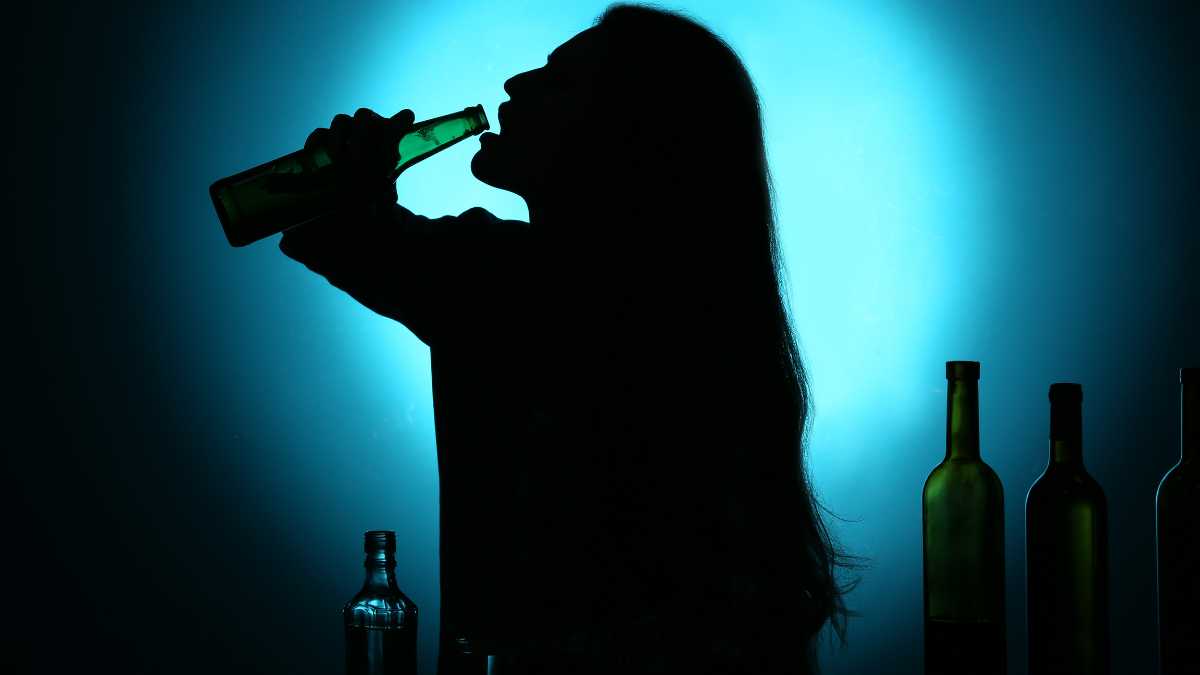Drunk driving is a major problem that affects not only the driver but also other road users, passengers, and pedestrians.
According to the National Highway Traffic Safety Administration (NHTSA), drunk driving was responsible for 13,384 deaths in 2021, a 14% increase from 2020.
That means every day, about 37 people in the United States die in drunk-driving crashes — that’s one person every 39 minutes. These deaths could have been avoided.
How Does Alcohol Affect Driving Ability?
Alcohol is a substance that reduces the function of the brain, impairing thinking, reasoning, and muscle coordination. These abilities are essential to operating a vehicle safely.

Some of the effects of alcohol on driving performance include:
- Reduced coordination, reaction time, vision, and hearing
- Impaired judgment, reasoning, self-control, and memory
- Difficulty steering, speed control, and emergency response
- Loss of attention, concentration, and visual search
Call Design for Recovery to Begin Your Healing Journey!
Reach out to our team to discuss sober living options and next steps toward a healthier routine.
The Effects of Blood Alcohol Concentration
Alcohol is absorbed directly through the walls of the stomach and small intestine. Then it passes and accumulates in the bloodstream until the liver metabolizes it.
The weight of the alcohol in a specific volume of blood measures a person’s alcohol level. This is called Blood Alcohol Concentration, or BAC.
BAC is measured with a breathalyzer, a device that measures the amount of alcohol in a driver’s breath, or by a blood test.
At a BAC of 0.08 grams of alcohol per deciliter (g/dL) of blood, crash risk increases exponentially. Because of this risk, it’s illegal in all 50 states, the District of Columbia, and Puerto Rico to drive with a BAC of 0.08 or higher, except in Utah where the BAC limit is 0.05.
However, even small amounts of alcohol can impair judgment, coordination, reaction time, vision, hearing, and memory. In 2021, 2,266 people were killed in alcohol-related crashes where drivers involved had a BAC of 0.01 to 0.07 g/dL.
The following table lists the effects of BAC on drivers at different levels:
Drunk Driving Statistics
According to the World Health Organization (WHO), alcohol-impaired drivers are a key risk factor for 27% of all road injuries and a significant source of injury, disability, and death worldwide.
Drunk driving is not only a threat to the driver’s life but also to the lives of others on the road. In 2021, among children (14 and younger) killed in motor vehicle crashes, 25% were killed in drunk-driving crashes. Of those deaths, more than half the time (55%), the child killed was in a vehicle driven by a drunk driver.
Alcohol-impaired driving also has economic and social costs. According to Forbes Advisor, drunk driving costs the U.S. economy $44 billion annually in medical expenses, lost productivity, property damage, and legal fees. This also damages the relationships, careers, and reputations of those involved.
Drunk Driving Risk Factors
- The risk of a fatal crash rises sharply with increasing blood alcohol content (BAC): at 0.08 g/dL BAC, the risk is four times higher, and at 0.15 g/dL BAC, it’s 12 times higher compared to sober drivers.
- Approximately 31% of US traffic-related deaths result from drunk driving with BAC levels of 0.08 or higher, even small alcohol amounts impair driving.
- Driver age influences crash risk: the 21-24 and 25-34 age groups have the highest percentage of alcohol-impaired drivers.
- In 2021, these age groups accounted for 27% and 25% of fatal crashes involving drivers with BACs of 0.08 or higher.
- Youthful drivers tend to binge drink and drive without seat belts, elevating injury risks.
- Drivers with past DUI convictions are more prone to repeating the offense and causing severe crashes.
- Around one-third of DUI offenders have prior convictions, and in 2021, 25% of drivers in fatal crashes had previous DUI convictions.
- Motorcycle riders are 28% more likely to be in fatal crashes than other vehicle types.
Contact Design for Recovery Today!
Fill out our quick form to connect with a peer mentor and learn how our sober living community supports accountability, structure, and personal growth in recovery.
Consequences of Driving Drunk
Alcohol-impaired driving can have devastating consequences for yourself and others. Not only are you putting your own life and health at risk, but you are also endangering the lives of other road users, passengers, pedestrians, and cyclists.
Drunk driving crashes can result in serious injuries, disabilities, emotional trauma, or death. Additionally, alcohol-impaired crashes can have legal, financial, and social repercussions. Depending on the scope of the crash, you may need to shoulder hefty costs from higher car insurance rates, legal fees, medical bills, or property damage.
Meanwhile, if you are convicted of driving under the influence (DUI) or driving while intoxicated (DWI), you may face charges ranging from misdemeanors to felony offenses.

Drunk Driving and Addiction Treatment
Frequent drunk driving reveals uncontrolled alcohol use—it's a dangerous warning that drinking overrides judgment, safety decisions, and personal responsibility.
- Medical detox: Supervised withdrawal in hospitals/clinics manages life-threatening symptoms like seizures, hallucinations, delirium tremens (DTs), and severe dehydration—essential first step for physical safety.
- Inpatient rehab: Residential programs offer 24/7 medical monitoring, intensive group/individual therapy, family counseling, and relapse prevention education in controlled environments.
- Outpatient programs: Flexible cognitive behavioral therapy (CBT), motivational interviewing, and support groups allow work/school balance while building coping skills for triggers like stress or social drinking.
- Medication-assisted treatment (MAT): FDA-approved options include naltrexone (blocks alcohol "high"), acamprosate (reduces cravings), and disulfiram (causes severe nausea if drinking), proven to double sobriety rates when combined with counseling.
Sober living bridges treatment gaps with substance-free house rules, random testing, daily peer accountability meetings, job training, financial planning, and 12-step integration, preventing the 60-80% relapse rate in the first year post-treatment.
Find Support for Alcohol Addiction
Don’t let drunk driving claim more lives. By choosing not to drink and drive, you can save yourself and others from harm.
However, if you’re struggling with controlling your alcohol consumption, it may be time to seek help.
Seeking support and making healthy choices can help you overcome addiction and live a fulfilling, sober life. Design for Recovery, a leading sober living home in Los Angeles, offers a safe and supportive environment with individualized care, peer mentorship, and life skills development for those struggling with addiction or substance abuse.
Remember, seeking help for alcohol addiction is a courageous step towards a healthier future. You don’t have to let alcohol control your life and your choices. Contact Design for Recovery today for a brighter tomorrow.
- How Does Alcohol Affect Driving Ability?
- The Effects of Blood Alcohol Concentration
- Drunk Driving Statistics
- Drunk Driving Risk Factors
- Consequences of Driving Drunk
- Drunk Driving and Addiction Treatment
- Find Support for Alcohol Addiction
Begin Lasting Sobriety Now!
Frequently Asked Questions
Drunk driving can impair judgment, vision, coordination, and reaction time. This can make you more likely to cause an accident, injure yourself or others, or damage property. Alcohol-impaired driving can also result in legal penalties such as fines, jail time, license suspension, or ignition interlock devices.
Drunk driving means operating a vehicle while under the influence of alcohol. The legal limit for blood alcohol concentration (BAC) varies by state, but generally, it is 0.08% or lower. However, even a tiny amount of alcohol can affect your driving ability.
The first thing to be affected when drinking alcohol is your brain. Alcohol affects the parts of your brain that control your mood, judgment, memory, and decision-making. This can make you more likely to take risks, act impulsively, or forget important information.
If you see someone driving erratically, weaving, swerving, or braking suddenly, they may be drunk. You can report alcohol-impaired driving or alcohol-impaired driving crashes by calling 911 and providing the location, description, and license plate number of the vehicle. Do not try to follow or stop the driver yourself.
The best way to prevent drunk driving is to avoid drinking and driving altogether. If you plan to drink alcohol, ensure you have a designated driver who will not drink at all or use alternative transportation such as public transit or ridesharing services.
According to the National Highway Traffic Safety Administration (NHTSA), about 31% of all traffic crash fatalities in the United States involve drunk drivers (with BACs of 08 g/dL or higher). In 2021, there were 13,384 people killed in these preventable crashes.
- https://www.cdc.gov/impaired-driving/about/index.html
- Dickson, M. F., Wasarhaley, N. E., & Webster, J. M. (2013). A Comparison of First Time and Repeat Rural DUI Offenders. Journal of offender rehabilitation, 52(6), 421. https://doi.org/10.1080/10509674.2013.813616
- Drunk driving. NHTSA. (n.d.). https://www.nhtsa.gov/risky-driving/drunk-driving
- Garrisson, H., Scholey, A., Verster, J. C., Shiferaw, B., & Benson, S. (2022). Effects of alcohol intoxication on driving performance, confidence in driving ability, and psychomotor function: A randomized, double-blind, placebo-controlled study. Psychopharmacology, 239 (12), 3893-3902. https://doi.org/10.1007/s00213-022-06260-z
- Hingson, R., & Winter, M. (2003, December). Epidemiology and consequences of drinking and driving . National Institute on Alcohol Abuse and Alcoholism. https://pubs.niaaa.nih.gov/publications/arh27-1/63-78.htm
- Masterson, L. (2023, April 6). Drunk driving statistics 2023. Forbes. https://www.forbes.com/advisor/car-insurance/drunk-driving-statistics/
- U.S. Department of Health and Human Services. (n.d.-a). Alcohol metabolism. National Institute on Alcohol Abuse and Alcoholism.
- https://www.niaaa.nih.gov/publications/alcohol-metabolism
- Utah Department of Public Safety. DPS – Highway Safety. (n.d.). https://highwaysafety.utah.gov/impaired/new-05-bac-law/







Written By
David Beasley